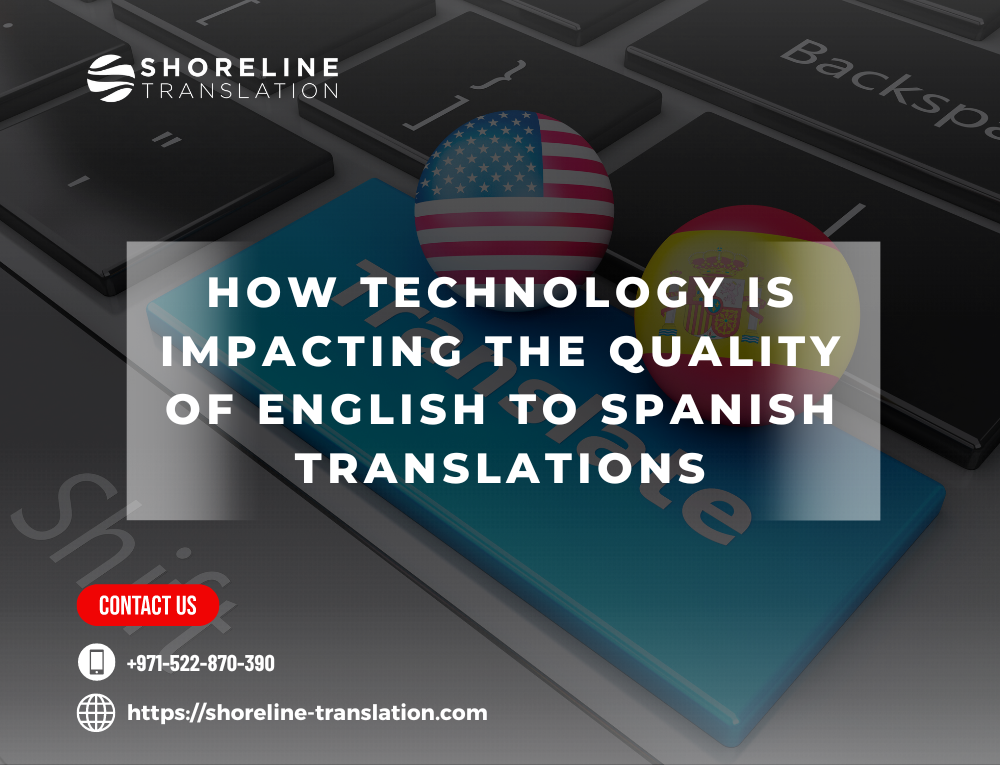Table of Contents
ToggleHow Technology is Impacting the Quality of English to Spanish Translations
We live in a world where technology is rapidly transforming the way we do business, communicate, and interact with one another. While some remain wary of its rapid growth, others are taking immense advantage of it to inform everyday transaction decisions. Nowhere is this more apparent than in the translation industry where English-to-Spanish translations have been improved greatly because of technological innovations. In this blog post, we’ll explore how tech advances are impacting translation quality for individuals and companies alike. We’ll examine which technologies have become especially valuable in assisting translators as well as their impact on the accuracy and delivery speeds of fully translated documents that can be used across organizations today. Join us as we take an in-depth look into the evolving landscape thanks to new technology!
Overview of the current state of technology-assisted English-to-Spanish translation
Technology-assisted translation (TAT) has become an increasingly popular way to translate English-to-Spanish documents. TAT relies on sophisticated software applications and linguistic databases to create translations that are accurate and efficient. With the help of artificial intelligence technologies, these systems can identify patterns in language and apply them accurately, allowing for more natural-sounding translations. TAT can be used for various documents, including legal and medical texts, financial documents, technical manuals, web content, and more. It is also becoming increasingly popular for translating social media posts and blog articles. The quality of the translation results from TAT systems varies depending on their level of sophistication. More advanced systems can provide more accurate translations, while basic systems may produce results that are less grammatically correct or contain inaccurate vocabulary.
In addition to accuracy and speed, TAT systems also allow for customization of the translation process, allowing users to add their glossaries and specific instructions to ensure better results. Overall, TAT is a powerful tool for creating accurate and efficient translations of English-to-Spanish documents in a variety of different contexts. With the help of artificial intelligence and other advanced technologies, TAT systems can provide more natural-sounding translations while remaining cost-effective. As technology continues to improve, TAT is likely to become even more widely used in the future.
The Pros and Cons of Technology-Assisted English-to-Spanish Translations
Pros:
– Faster and more efficient than manual translations done by individual translators.
– Can provide accurate translations on a larger scale, making them ideal for large businesses that may need to translate large amounts of material quickly.
– More cost-effective than hiring multiple human translators.
– Automated technology can often pick up on nuances in a language not easily understood by humans, avoiding errors and misunderstandings that could occur in traditional translations.
– English to Spanish translations are relatively easy when compared to other languages due to the close relationship between the two languages.
Cons:
– Errors in automated translation technology, such as grammar mistakes or mistranslations, can lead to confusion or misinterpretation of the original text.
– Automated technology can be susceptible to culture-based mistakes, as it does not have an understanding of the context in which words are used.
– Machines lack common sense and may fail to recognize slang or other idioms.
– English to Spanish translations often require cultural knowledge that machines do not possess.
– Despite advances in translation technology, human translators are still needed to proofread automated translations and make sure they meet quality standards.
In conclusion, while there are advantages and disadvantages associated with using technology-assisted English-to-Spanish translations, automation is becoming increasingly important for businesses looking to translate large amounts of material quickly and accurately. This type of service can provide cost savings and higher levels of accuracy than manual translations done by individual translators. However, it is important to remember that human translators should still be used to proofread automated translations and make sure they meet quality standards.
Ultimately, the effectiveness of any translation service will depend on the context of the material being translated and the skill level of both the machine and human translators involved.
Quality Control Measures for Accurate English-to-Spanish Translations
– Utilize translation memory tools to ensure consistency of translations and reduce the amount of time spent on redundant work.
– Leverage a team of experienced translators to triple-check all translated documents for accuracy before the document is finalized.
– Use authoritative reference sources such as monolingual, bilingual, and terminology dictionaries to verify that proper language has been used in the translation process.
– Have native Spanish speakers review all content before submission, ensuring that appropriate syntax and context have been applied throughout the entire document.
– Vet any automated machine or computer translations with human resources who can provide additional quality assurance and correction where necessary.
– Determine if localization or cultural considerations are necessary to accurately convey the intended message.
– Utilize automated quality assurance tools to ensure that all documents meet strict format requirements and standards.
– Regularly review your team’s translation processes and procedures, ensuring that they remain up-to-date with global best practices and industry regulations.
– Develop a feedback system so your staff can share any insights or observations they may have on improving their translation performance.
– Utilize rigorous quality assurance testing to check for the accuracy and performance of all translations before they are sent out.
– Maintain a database of past translations, so that any potential issues can be quickly identified and corrected if necessary. This will also help speed up the future translation process.
By following these steps and utilizing the right tools and resources, you will ensure that your English-to-Spanish translations are accurate, precise, and error-free. You will also have peace of mind knowing that your content is translated by experienced professionals who understand the nuances of both languages, giving you the best possible results every time.
Tools Used to Enhance Quality in English to Spanish Translations
When it comes to ensuring quality in English to Spanish translation services, there are many tools available that can be used to enhance the accuracy of a translation. One popular tool is machine translation. This technology uses algorithms and statistical models to generate an automated translation from one language into another. While such translations may not always be perfect, they can often provide helpful insights into certain aspects of a text or document that require clarification before proceeding with a more human-driven translation process. Other tools that can help enhance the quality of English-to-Spanish translations include:
– Translation Memory (TM): A software program designed to store previously translated texts and reuse them in subsequent projects. This helps ensure consistency in terminologies and expressions throughout a project.
– Glossaries: A curated list of terms and phrases specific to a particular subject or industry, which can be used as reference materials in translations.
– Quality Assurance (QA) Tools: These tools check for errors in grammar, spelling, punctuation, and style that may have been overlooked during the translation process.
By using such tools, it is possible to pinpoint errors quickly and accurately so they can be corrected before the translated text is released for publication. Together, these tools can help ensure that any English-to-Spanish translation projects are of high quality and accuracy. In addition to the tools mentioned above, several other methods can be used to enhance the quality of English-to-Spanish translations. These include:
– Proofreading by native speakers: A professional translator should have a good command of both languages and should be able to spot any errors or inconsistencies in a translation. By having a qualified native speaker review a translated text, it is possible to ensure its accuracy and correctness.
– Quality Assurance (QA) Testing: This uses software programs to test for typos, grammar mistakes, incorrect words, and other inaccuracies in a translated text before it is released for publication. This helps ensure that only accurate versions of texts are published.
– Cross-checking with sources: Checking a translated text against its source is essential to ensure accuracy and completeness.
By doing so, it is possible to identify any discrepancies between the original content and the translation and rectify them before publishing. Taken together, these tools can help ensure that English-to-Spanish translations are of high quality, accurate, and reliable.
By using such methods, it is possible to provide clients with top-notch translations that they can trust and depend on. In addition to the tools mentioned, professional translators can also benefit from using translation review software. This type of software is designed to provide detailed feedback on a translated text and suggest areas for improvement.
By using this tool, it is possible to pinpoint errors quickly and accurately so that they can be corrected before publishing. In summary, a combination of tools and techniques should be used to ensure quality English-to-Spanish translations. This includes machine translation, TM, glossaries, QA tools, proofreading by native speakers, QA testing, cross-checking with sources, and translation review software. By utilizing these methods, it is possible to obtain accurate and reliable translations that clients can count on. The use of such tools and techniques will help to ensure that English-to-Spanish translations are of the highest standard.
How Technology is Making an Impact on English-to-Spanish Translation Quality and Accuracy
As technology continues to advance, the quality and accuracy of English-to-Spanish translation are rapidly improving. Machine translation (MT) tools are becoming increasingly sophisticated, providing real-time translations in multiple languages with incredible accuracy. The ability to quickly understand context has enabled MT to more accurately capture nuances that until recently had been impossible for computers to comprehend. This has resulted in improved natural language processing capabilities, allowing machine translators to better interpret the meaning and provide more accurate translations.
With the help of artificial intelligence, machines are now able to learn from their mistakes and quickly adapt to new words and phrases. AI powers such technologies as neural networks that can autonomously detect patterns in large datasets, allowing for rapid advances in translation quality. Additionally, voice recognition technology is transforming the way we interact with machines, allowing us to directly ask questions in our native language and receive translations in real time.
At the same time, human translators are also benefiting from improved tools and technologies. With digital tools such as translation memory (TM) software, any previously translated text can be stored and easily reused for future projects. This not only helps speed up the translation process but also improves consistency and accuracy by eliminating the need to translate certain phrases repeatedly. Furthermore, document comparison software allows linguists to review documents side-by-side and identify differences more quickly and accurately than ever before. By leveraging these new technologies, translators can provide more accurate translations faster than ever before.
In conclusion, technology has had a tremendous impact on the quality and accuracy of English-to-Spanish translation. With advances in machine translation, artificial intelligence, voice recognition, and other tools, translations are now more accurate than ever before. Human translators also benefit from improved technologies such as TM software and document comparison software. As a result, organizations can rest assured that their Spanish translations are of the highest quality and accuracy available.
Tips for Ensuring Accurate Results from Machine English-to-Spanish Translation Software
- Use good quality machine translation software and make sure that it is up-to-date and has the most recent version of the language you are translating to.
- Double-check all translations for accuracy by running them through both a human translator and a spellchecker.
- Keep your sentence structure as simple as possible; avoid using long or complicated sentences since this may lead to inaccurate translation results from the software.
- Ensure that any technical terms or specialized language used in the text are translated accurately by using separate dictionaries dedicated to these words, if available.
- Be aware of regional dialects and cultural elements; different countries have different ways of expressing ideas which could lead to the wrong interpretation by machine translation software.
- Avoid slang terms, colloquialisms, or any other words that have a specific meaning in one language but not necessarily in another.
- Make sure your source texts are as accurate and error-free as possible since even minor errors can cause major problems with translation accuracy.
- Provide context for words or phrases that may be difficult to translate; this will help the software to make better choices about how to render them into Spanish accurately.
- Consider using a hybrid approach; combining machine translation with professional human translation can greatly improve the accuracy of results while minimizing overall costs and time spent on translating content.
- Test the output of any machine translations before releasing it; even though machines can’t always capture the nuances or subtleties of language, they can produce surprisingly accurate results if used correctly.
These tips can help to ensure that your machine English-to-Spanish translations are as accurate and reliable as possible. By taking the time to understand how machine translation works, you can make sure that your translations meet the highest standards of quality. Good luck!
Shoreline Translation Office offers professional translation of English into Spanish
Shoreline Translation Office provides translation services for all types of documents, including legal contracts, business correspondences and presentations, academic papers, medical reports, and more. Our team consists of experienced translators who specialize in Spanish-language translations.
We guarantee accurate translation with the highest quality standards in the industry. No matter how big or small your project is, we will work with you to make sure that your translations are of the highest quality. We provide fast and reliable services, so you can be assured that your project will be done quickly and accurately.
In addition, we also offer proofreading services to ensure accuracy and professionalism in all our translated documents. Contact Shoreline Translation Office today for all of your Spanish-language translation needs. We look forward to assisting you! Thank you for choosing Shoreline Translation Office!
FAQ
Q: What does it mean to translate from English to Spanish?
A: Translating from English into Spanish means taking a text written in English and converting it into a complete, accurate version of the original text in Spanish. This process involves not only translating words but also adapting sentence structure, grammar, and syntax so that the translated text conveys the same meaning as its source.
Q: How can I be sure that my translations are accurate?
A: The best way to make sure your translations are accurate is to use professional translators with experience in the language they’re working with. You should also double-check any machine translations you use with both human translators and Spanish-speaking native speakers. Finally, be sure to proofread the final product thoroughly to make sure it meets the highest standards of accuracy.
Q: What services does Shoreline Translation Office provide?
A: Shoreline Translation Office provides professional translation services for all types of documents, including legal contracts, business correspondences and presentations, academic papers, medical reports, and more. We also offer proofreading services to ensure accuracy and professionalism in all our translated documents. Contact us today for all your Spanish-language translation needs! We look forward to assisting you! Thank you for choosing Shoreline Translation Office!
Conclusion
In conclusion, technology plays a critical role in the accuracy of machine translations. Users should be aware that automated translations are still in their infancy and can often be inaccurate. It is important to research options such as hiring a trained linguist or utilizing language-learning software appropriately when making translations between English and Spanish documents. Human experts are better able to ensure nuanced interpretation of subtle language nuances despite advances in technology – even with speech recognition tools like automatic voice translation programs. By using the right tool with expertise, there is still no substitute for a human translator experienced in the languages used. Furthermore, not just any human translator will do; it must be someone who can specifically work with English to Spanish translations that meets your quality standards. At Shoreline Translation Office, we offer expert translation services for exactly this purpose and would be delighted to help you with all your translation needs!






